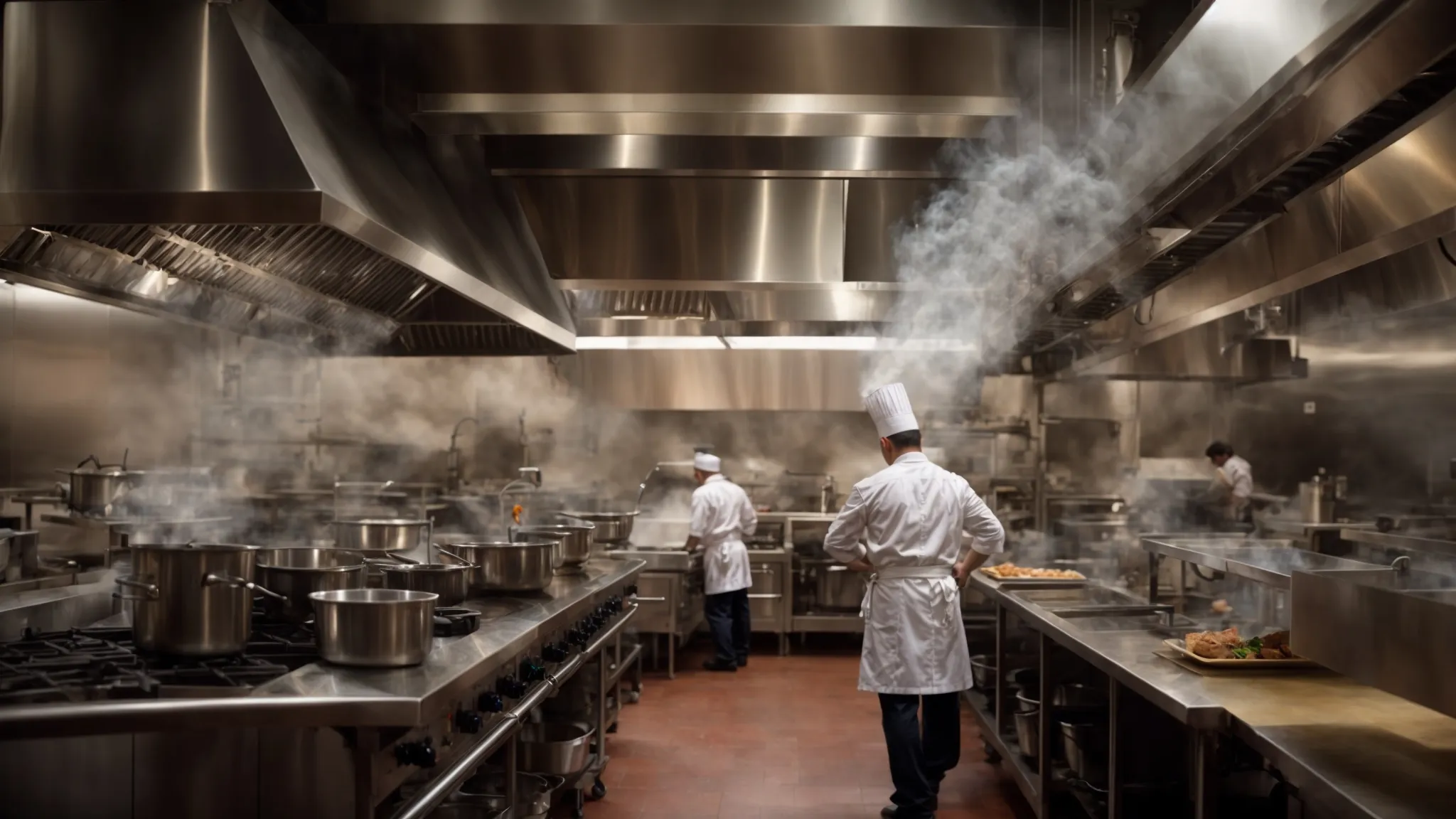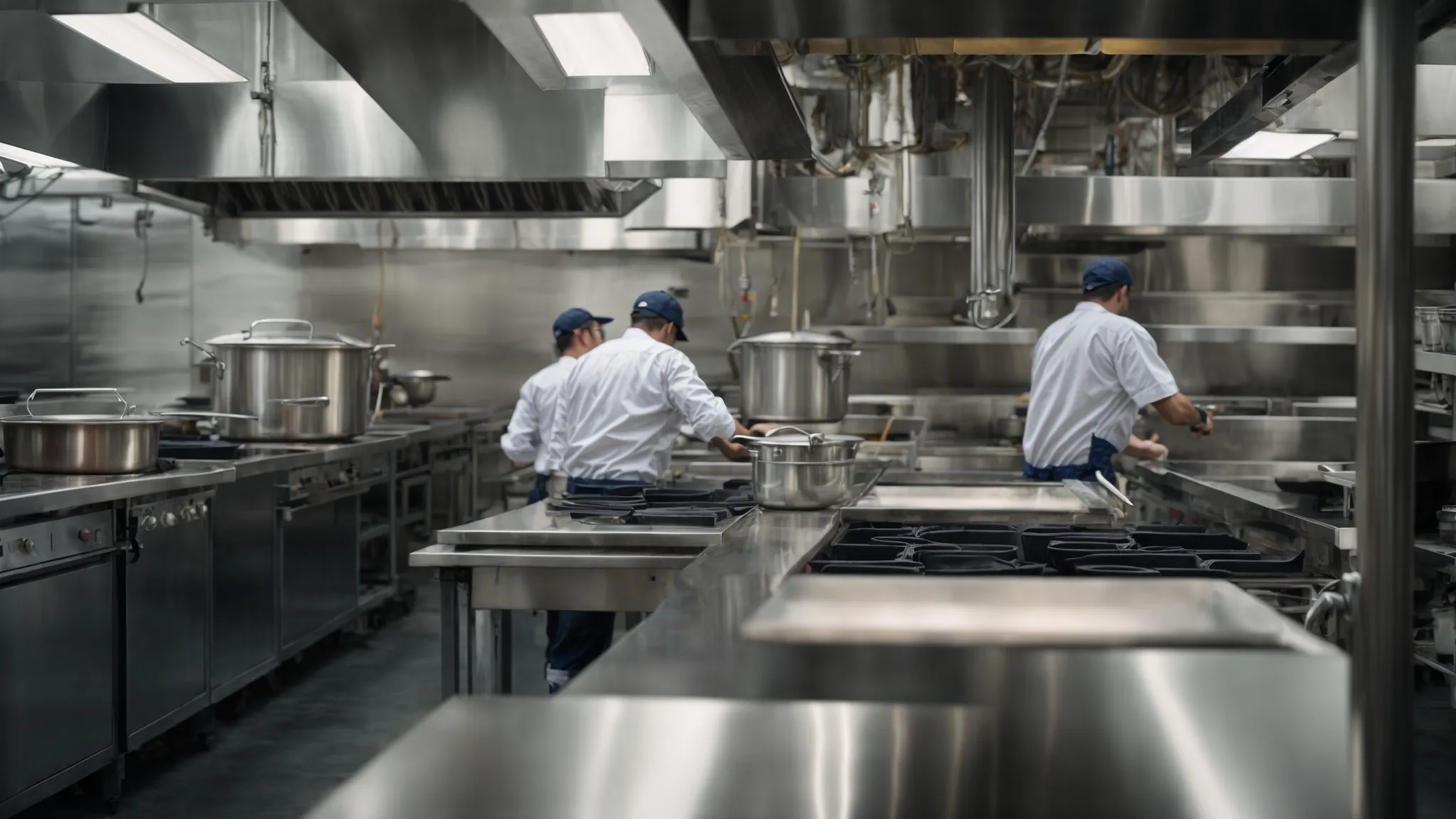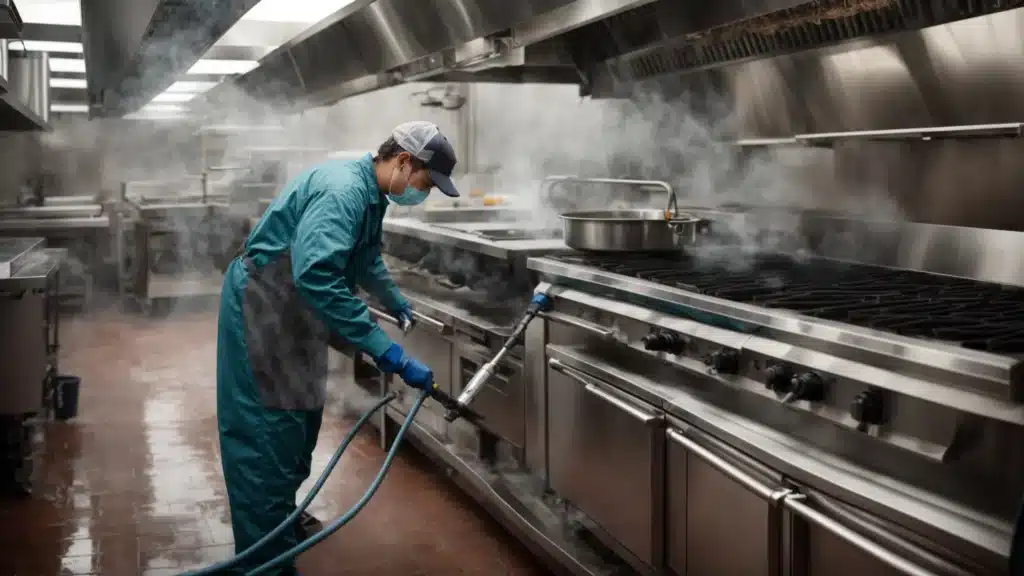Understanding the Role of Regular Hood and Kitchen Exhaust Cleaning in Health and Safety
Kitchen Exhaust Cleanliness: A Health and Safety Guide
The kitchen, often the heart of any food service establishment, holds more secrets than just tantalizing recipes – among these, the exhaust system, a labyrinth where grease and safety concerns can easily amass.
Keeping this system clean isn’t just about maintaining aesthetic standards; it’s about ensuring the very air that shrouds your culinary creations remains as pristine as the dishes served.
Kitchen exhaust cleanliness transcends mere sparkle, embedding itself as a crucial facet of both health and safety protocols, guarding against fires and contaminants.
Delving into the layers of grease and debris requires a blend of elbow grease and know-how, a ritual that safeguards the well-being of both guests and staff alike.
In this article, we unveil the cloak of complexity surrounding the art of kitchen exhaust cleaning, guiding you through the steps to achieve not just compliance, but peace of mind.
Key Takeaways
- Regular and Thorough Cleaning of Kitchen Exhaust Systems Is Crucial for Mitigating Fire Hazards and Maintaining Indoor Air Quality
- Accumulation of Grease and Debris in Exhaust Systems Creates Significant Health Risks and Fire Hazards
- Utilizing the Right Tools and Cleaning Agents Is Essential for Effective Kitchen Exhaust Maintenance
- Adherence to National Fire Protection Association (NFPA) Standards and Local Health Codes Is Mandatory to Avoid Legal Penalties
- Choosing a Reputable Cleaning Service With Experience and Proper Liability Insurance Ensures Compliance and Promotes Kitchen Safety
Understanding the Importance of Kitchen Exhaust Cleaning

In the heart of every restaurant kitchen, the exhaust system operates silently yet significantly, acting like the lungs of the operation—expelling smoke, heat, and odor to keep the environment clean and safe.
However, lurking within these crucial systems, a myriad of health risks and fire hazards can accumulate unnoticed.
Identifying the myriad health risks associated with unclean exhaust systems is not just a matter of maintaining indoor air quality; it’s a crucial step in safeguarding the well-being of staff and patrons alike.
Concurrently, the role of a clean kitchen exhaust transcends mere cleanliness—it’s a fundamental pillar in fire prevention strategies.
Accumulated grease and debris act much like tinder in the forest, waiting for a spark to ignite an inferno, making regular and thorough exhaust cleaning an indispensable safety protocol rather than a mere chore.
Identifying the Health Risks Associated With Unclean Exhaust Systems
An unclean kitchen exhaust system becomes a hidden harbor for airborne contaminants, including grease, dust, and other particulates. These pollutants can easily circulate within a restaurant’s indoor environment, significantly deteriorating the air quality and posing respiratory risks to both employees and patrons.
Moreover, the accumulation of grease and debris within the exhaust system nurtures the perfect breeding ground for bacteria and mold. This not only contaminates the air but can also compromise food safety, indirectly affecting the health of those consuming the meals prepared in the kitchen.
The Role of a Clean Kitchen Exhaust in Fire Prevention
The anticipation of fire hazard in a restaurant kitchen is as dense as a thicket of dry woods, ready to catch at the slightest provocation. Ensuring that the kitchen exhaust is pristine not only acts as a barricade against the spread of flames but also significantly minimizes the risk of catastrophic events originating from the cooking area. This meticulous attention to cleanliness acts as a silent guardian, warding off the dread of unforeseen disasters.
It’s a little-known fact that the majority of kitchen fires find their kindling within the greasy veins of a neglected exhaust system. By embracing rigorous cleaning regimens, establishments place a steadfast sentinel against the incendiary threats posed by accumulated grease and debris. Such preventive measures illuminate the path to a safer kitchen environment, thwarting the ignition of potential fires before they have a chance to erupt into chaos.
As the curtain falls on the why, a new scene unfolds – how. Let’s roll up our sleeves and dive into the heart of kitchen exhaust cleaning preparation.
Preparing for a Thorough Kitchen Exhaust Cleaning

Embarking on the journey of kitchen exhaust cleaning is akin to preparing for a meticulous operation, where precision and safety intersect to forge a path toward a healthier, hazard-free environment.
The first step in this task requires the assembly of appropriate tools and cleaning agents, each selected with the purpose of dismantling the armor of grease and grime that shields potential dangers.
Simultaneously, draft a blueprint of safety precautions, an indispensable guide designed to navigate through this process unscathed.
Recognizing the gravity of what’s at stake, these preparatory measures are not merely preliminary steps but the foundation upon which the sanctity of kitchen hygiene and safety is built.
Gathering Essential Tools and Cleaning Agents
Initiating the cleaning of a kitchen exhaust system commences with a meticulous selection of tools and cleaning agents, each tailored to combat the rigidity of grease and the stubbornness of accumulated debris. This arsenal might include degreasers of industrial strength, sponges that don’t shy away from scrubbing, and brushes that can delve into the smallest crevices to ensure not a spot is left unchecked.
Additionally, the need for specific equipment such as pressure washers, vacuums equipped with HEPA filters for trapping fine particles, and perhaps even steam cleaners for an in-depth purge, underscores the commitment to a thoroughly sanitized exhaust system. As these tools and agents gather, each stands as a testament to the gravity of the task at hand: the transformation of a grease-laden hazard into a beacon of cleanliness and safety:
- Industrial-strength degreasers to dissolve stubborn grease buildup.
- High-efficiency particulate air (HEPA) vacuums to capture even the finest particles.
- Sturdy brushes and sponges designed for rigorous scrubbing and reaching into nooks and crannies.
- Pressure washers and steam cleaners to effectively remove layer upon layer of grime and debris.
Safety Precautions to Consider Before Starting the Cleaning Process
Prior to embarking on the vital task of kitchen exhaust cleaning, setting the stage with appropriate safety gear stands paramount: this ensemble serves as a guardian against potential harm. Equipping oneself with gloves to ward off chemical burns, goggles to shield eyes from debris, and masks to filter out harmful particulates ensures that defenders against kitchen pollutants are well-armored for the battle against grease and grime.
Moreover, understanding the architecture of the exhaust system crystallizes as a crucial preparatory step before initiation. This knowledge not only prevents accidental damage during the cleaning process but also aids in identifying specific areas prone to grease accumulation and potential fire hazards. Clear communication and coordination with the restaurant staff regarding the cleaning schedule minimize disruptions and enhance safety for all involved:
| Safety Gear | Pre-cleaning Preparation | Communication |
|---|---|---|
| Gloves, goggles, masks | Understanding exhaust system layout | Informing staff of cleaning schedule |
Now that we’ve armed you with the knowledge to prepare for a deep clean, the adventure doesn’t stop here. Fasten your apron, as we’re about to embark on the step-by-step journey to master DIY kitchen exhaust cleaning.
Step-by-Step Guide to DIY Kitchen Exhaust Cleaning

In the crusade for a pristine and safe kitchen, addressing the heart of your exhaust system becomes paramount.
Diving into the do-it-yourself realm of kitchen exhaust cleaning empowers restaurateurs and kitchen managers with the tools and knowledge necessary to maintain paramount health standards and fire safety precautions.
This comprehensive guide seamlessly transitions you through the pivotal steps of removing and meticulously cleaning filters for optimized airflow, ensuring every breath within the kitchen is as fresh as the cuisine served.
It doesn’t stop there; armed with tried-and-tested techniques, the journey continues to the very veins of your establishment – the ducts, fans, and hoods.
Through effective scrubbing practices, this guide illuminates the path to not just cleanliness but the preservation of a thriving, hazard-free kitchen environment.
Removing and Cleaning Filters for Optimal Air Flow
The journey towards optimal air flow begins with the meticulous removal and cleaning of kitchen exhaust filters: gatekeepers that stand vigilant against the invasion of grease and particulates. These filters function as the first line of defense, ensuring that the air within the kitchen remains as clean as the dishes it produces.
Once removed, the true testament to cleanliness unfolds through a methodical cleaning process, stripping away layers of accumulated grease and grime. This not only rejuvenates the filters but also restores their ability to safeguard the kitchen environment from unwanted pollutants and hazards:
- Detach the filters carefully to avoid damage to the surrounding areas.
- Submerge the filters in a solution of warm water and a non-corrosive detergent, using a sponge or brush for scrubbing.
- Rinse thoroughly with clean water, ensuring all detergent and loosened debris is washed away.
- Allow the filters to dry completely before re-installing them, to prevent moisture from becoming a breeding ground for bacteria.
Techniques for Scrubbing Down Ducts, Fans, and Hoods Effectively
Moving beyond the primary barrier of filters, the crusade against grease and grime extends its frontier to the ducts, fans, and hoods: the conduits of cleanliness that define the very breath of a kitchen. Initiating this phase is both a meticulous and careful endeavor, where using a combination of industrial-strength detergents and manual tools—such as long-handled brushes and scrapers—becomes imperative. This ensemble of cleaning agents and tools works in unison to dislodge and wash away the layers of accumulated dirt, ensuring that nothing short of a polished passage remains.
| Zone | Tool | Detergent | Technique |
|---|---|---|---|
| Ducts | Long-handled brushes | Industrial-strength degreaser | Scrubbing and dislodging |
| Fans | Scrapers | Heavy-duty soap | Detail cleaning |
| Hoods | Microfiber towels | Non-abrasive cleaner | Polishing |
Success in these efforts not only hinges on the selection and application of the right tools and detergents but also on a technique that is both thorough and gentle: an approach that removes the unwelcome layers of grime without compromising the integrity of the metal beneath. This delicate balance ensures the longevity and efficiency of the kitchen’s ventilatory guardians, setting a gold standard in cleanliness that echoes throughout the establishment.
Embark on this journey from DIY mastery to unveiling the secrets of professional kitchen exhaust maintenance. Let’s elevate your skills to the next level with expert tips that shine a new light on cleanliness.
Professional Kitchen Exhaust Maintenance Tips

Transitioning from do-it-yourself efforts to embracing the expertise of seasoned professionals marks a critical step in the maintenance of kitchen exhaust cleanliness and safety.
Meticulous upkeep of this vital system requires not only a keen eye for detail but also a deep understanding of the intricate mechanics at play.
To safeguard the health and safety of both staff and patrons, establishing a routine of regular professional checks becomes indispensable.
This regimen ensures that the depths of grease and debris, beyond the reach of daily cleaning practices, are thoroughly addressed.
However, the effectiveness of such measures heavily leans on the caliber of the service provider chosen.
Evaluating potential candidates based on their track record of quality and accumulated experience in the field stands as a testament to a restaurant’s commitment to upholding the highest standards of cleanliness and fire safety.
Scheduling Regular Professional Checks for Deep Clean Needs
In the labyrinth of professional kitchen operations, scheduling regular professional checks for kitchen exhaust systems emerges as a crucial strategy for fire safety and air quality management. These scheduled audits serve as a crucial lynchpin, ensuring the deepest recesses of an exhaust system remain free from hazardous accumulations of grease and debris:
| Service Interval | Focus Areas | Expected Outcomes |
|---|---|---|
| Quarterly | High-grease production areas | Reduced risk of fire hazards |
| Bi-annually | Standard cooking stations | Optimized airflow and efficiency |
| Annually | Low-grease volume kitchens | Assured overall air quality and cleanliness |
By adhering to a meticulously crafted inspection and maintenance schedule, establishments can effectively mitigate the risks associated with neglected kitchen exhaust systems. The essence of this practice transcends routine cleaning efforts, embedding a culture of proactive safety and hygiene maintenance within the culinary industry.
Evaluating Service Providers Based on Quality and Experience
In the quest for unparalleled kitchen exhaust maintenance, the discernment of selecting a service provider anchored in both quality and experience becomes paramount. A company’s historical performance, evidenced through reviews and testimonials, serves as a lighthouse, guiding restaurateurs through the fog of choices to a partner capable of maintaining the symbiosis of safety and cleanliness in commercial kitchens.
Moreover, the mastery of a service provider in navigating the intricate requirements of the National Fire Protection Association (NFPA) standards, coupled with their liability insurance and adherence to local regulations, crystallizes their competency. The accumulation of experience over years, if not decades, ensures that the cleaning process illuminates every hidden nook, reducing risks and fortifying a restaurant’s commitment to health and fire safety.
Shifting gears, we plunge into the intricate world of legal requirements for commercial kitchen exhaust systems. Here, compliance and safety intertwine, laying a critical foundation for any culinary establishment’s success.
The Legalities Surrounding Commercial Kitchen Exhaust Systems

Navigating the legal landscape of commercial kitchen operations requires an acute awareness of the regulations governing exhaust system cleanliness. In Ontario, as in many parts of Canada, strict guidelines ensure that establishments adhere to standards aimed at minimizing fire risks and protecting public health. These regulations are not mere suggestions but enforceable mandates that carry significant implications for compliance.
At the heart of these regulations, the National Fire Protection Association (NFPA) standards stand as a critical benchmark. The NFPA’s directives serve as a comprehensive guide, detailing the practices necessary to maintain kitchen exhaust systems in a manner that significantly reduces the likelihood of fires. Establishments found in violation of these standards may face severe penalties, including fines or operational suspensions, underscoring the importance of compliance.
Furthermore, local health codes extend the spectrum of legal requirements, focusing on the broader implications of exhaust system cleanliness on indoor air quality and food safety. These statutes are designed to combat airborne contaminants, ensuring that the environment within commercial kitchens remains conducive to both staff well-being and the preparation of safe, clean food. Failure to adhere to these health codes not only jeopardizes public health but also exposes establishments to legal scrutiny and potential litigation.
Compliance with these legal requirements rests on the shoulders of kitchen operators, demanding a proactive approach to exhaust system maintenance. Engaging with reputable cleaning services that understand the nuances of local and national regulations provides an essential shield against the legal ramifications of neglect. In the intricate dance of kitchen operations, the cleanliness of the exhaust system is a step that cannot be overlooked, safeguarding against the twin threats of legal action and compromised safety.

